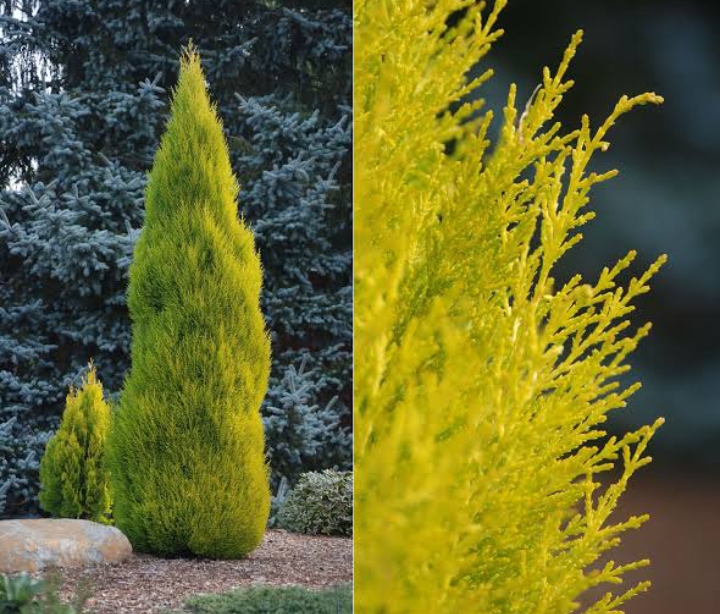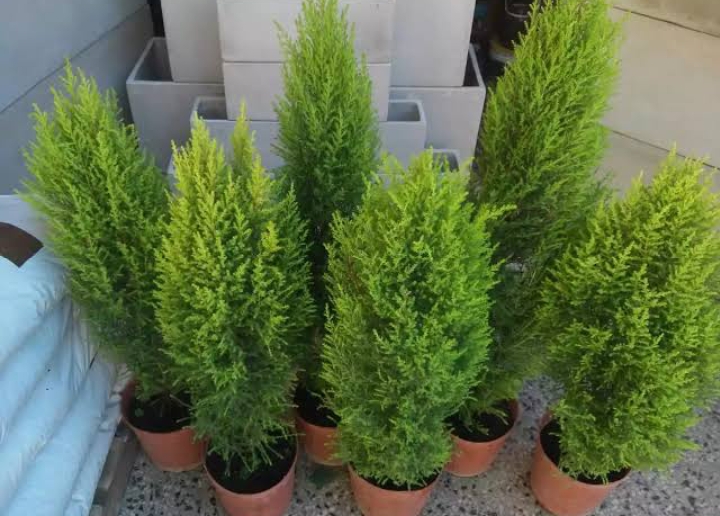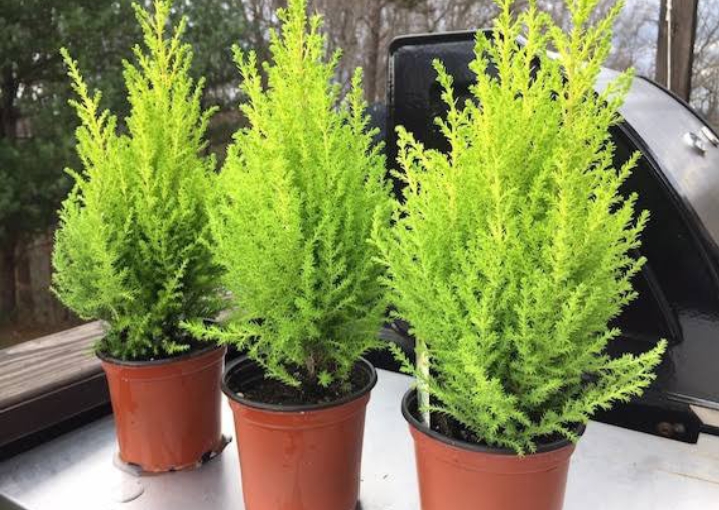Lemon cypress, scientifically known as Cupressus macrocarpa ‘Goldcrest,’ is a type of cypress of shrubby nature commonly grown indoors or commercial landscapes. It is also commonly referred to as the Goldcrest Monterey Cypress. It is a specific cultivar of the Monterey cypress with an upward-growing branches and golden-foliage that emits a lemony scent.
This article tries to look at its origins, cultivation requirements, aesthetic appeal and its various practical uses.
Facts About Lemon Cypress

- The lemon cypress, (Cupressus macrocarpa ‘Goldcrest)’ is a cultivar of the Monterey cypress.
- It is native to the Monterey, California coastal area.
- The lemon cypress is evergreen in nature, in the sense that it retains its foliage throughout the year.
- Lemon cypress has a compact and columnar growth habit. It reaches a height of 6 to 16 feet.
- The leaves are needle-like and are bright yellow-green or golden in color.
- The needles are aromatic in nature. When gently brushed or crushed, the foliage releases a lemony fragrance.
- Lemon cypress is easy to grow and is relatively a low-maintenance plant.
- The tree can be grown both indoor and outdoors.
- Lemon cypress thrive in USDA plant hardiness zones 7 through 10.
- This cypress has a lifespan of between 30 and 50 years.
Landscaping Uses For Lemon Cypress Tree
- Accent Plant: Lemon cypress can be used as an accent plant in a front yard. When used as an accent plant, the vibrant yellow foliage of the cypress looks particularly beautiful especially if there are green plants or flowers within the yard.
- The cypress can still work well as standalone specimen, drawing attention to a specific spot in the yard. By placing or growing at strategic locations, such as entrances, pathways or along the edges of seating areas, the cypress can guide the viewer’s gaze and direct attention to specific focal points or vistas.
- Hedge or Privacy Screen: Due to its dense growth habit, lemon cypress can be planted in rows to create a hedge or privacy screens and help to block unwanted views in privacy outdoor spaces.
- Container Planting: Lemon cypress grows best when in containers and therefore it can be good for adding vertical interest to patios, balconies or entryways.
- Topiary: The lemon cypress’s slender and flexible branches are good for topiary art. With regular pruning and shaping, it can be trained into various ornamental forms, such as spirals, cones, or geometric shapes.
- Rock Gardens: Rock gardens usually have sandy, rocky or gravelly soil, which may lack organic matter and nutrients. This cypress tree can just grow fine in such poor soil condition without so much requirements, in fact its yellow needles contrast beautifully against the rugged textures and muted colors of rocks and boulders.
- Mediterranean or Coastal Landscapes: Lemon cypress has a Mediterranean origin and can work well is for landscapes with a Mediterranean or coastal theme. When planted along gardens near the sea or among rocks and boulders, it brings a sense of being in a natural environment.
How to grow And Care For Lemon Cypress In Pots
Lemon cypress is a relatively easy to grow plant and can be grown both indoors and outdoors, depending on the climate. If you’re interested in growing lemon cypress, here are some essential tips to help you along the way.
Soil
Lemon cypress grows best in a well-draining soil, that is, soil that is rich in organic matter and retains some moisture without becoming waterlogged. Sandy loam or loamy soil types are generally good in this regard. If you prefer growing it in a container, use a mixture of potting soil, sand and perlite.
Another thing is that this cypress prefers soil with a pH range of 6.0 to 6.5. If the pH of your soil is too high (alkaline), you can lower it by adding elemental sulfur or other soil acidifiers.
Light
Lemon cypress grows well in full sun to partial shade. Ensure that you grow the plant in an area that receives a lot of sunlight daily. If you’re growing it indoors, place it near a south-facing window to maximize sunlight exposure. When growing outdoors, choose a location that receives preferably a lot of morning sun to mid-day sun.
Temperature
Given that the Lemon cypress is native to coastal regions of California and therefore, it will just be fine with moderate temperatures. It is not tolerant of extreme heat or cold. In general, the cypress will grow well with temperatures of between 60°F (15°C) and 75°F (24°C) during the day.
The cypress is hardy in USDA hardiness zones 7 to 10. It can tolerate mild winter conditions, but it may suffer damage or die if exposed to severe cold or freezing temperatures for a long period. In colder regions, it is best to grow lemon cypress in containers that can be brought indoors when temperature fall to sub-zero levels.
Watering
Lemon cypress requires regular watering to grow well, especially during the dry seasons of the year. When growing it in pots, before watering, check the moisture level by sticking your finger about an inch into the soil. If it feels somehow moist, it may not require immediate watering. If it feels dry, it’s time to water.
When watering lemon cypress, it’s essential to ensure the water reaches the root zone. Use a watering can with a gentle flow and direct the water at the base of the tree. After watering, apply a layer of organic mulch around the base to help conserve soil moisture.
Fertilizing

Lemon cypress require a balanced supply of nitrogen (N), phosphorus (P), and potassium (K), along with minor nutrients such as iron, manganese and magnesium.
Look for a balanced, slow-release granular fertilizer formulated for evergreens. Such fertilizers usually have an N-P-K ratio of 10-8-6 or similar, with additional micronutrients. You can also use an organic fertilizer like compost or well-rotted manure.
You will need to apply the fertilizer to the cypress tree during the active growing season, which is in spring and early summer. For best application, follow the instructions on the fertilizer package.
Pruning
The best time to prune lemon cypress is during its dormant season, in late winter or early spring before new growth starts. Start by inspecting the tree for any dead, damaged or diseased branches. Selectively prune branches that are crossing, rubbing against each other, or growing inward. Remove them at their point of origin ideally near the main trunk.
If you want to control the height or width of the tree, prune the leading shoots or side branches accordingly. After pruning, water the tree adequately and provide fertilization to support its recovery and encourage new growth.
Common Diseases
Here are some diseases commonly associated with growing lemon cypress:
- Canker: Canker usually affects the trunk or wood of lemon cypress. It makes the trunk and branches to appear as sunken or discolored areas on the trunk or branches. The affected areas may ooze sap or resin.
- Root Rot: Excessive moisture or poor drainage can create a favorable environment for root rot to take effect leading to wilting and eventual death of the plant. If root rot is detected, it may be necessary to improve drainage and repot after treating the roots with fungicides.
- Needle Blight: Needle blight causes browning, discoloration and needle drop. The disease is usually more prevalent in damp or humid conditions. Pruning infected branches and providing good air circulation can help manage needle blight.
Common Pests

Here are some common pests associated with growing lemon cypress:
- Cypress Aphids: These aphids gather in large numbers on the new growth, causing browning and drop of the needles. They sometimes secrete honeydew, which attracts ants and promote the growth of sooty mold.
- Cypress Tip Moth: The larvae of these small moths burrow into the tips of the branches and feed on the tender growth, making the tips to turn brown or die back. Infested branches may also produce resinous droplets or webbing.
- Spider Mites: Severe infestations can lead to needle drop and overall decline of the plant. Spider mites are often more prevalent in dry and dusty conditions.
- Scale Insects: These small insects attach themselves to the branches and suck sap. Infestations can result in wilting and stunted growth. The presence of scale insects can also result in the development of sooty mold on the needles.
- Caterpillars: Certain caterpillars can feed on the foliage of lemon cypress, causing extensive damage if left unchecked. Large infestations can defoliate the cypress and weaken its overall health.